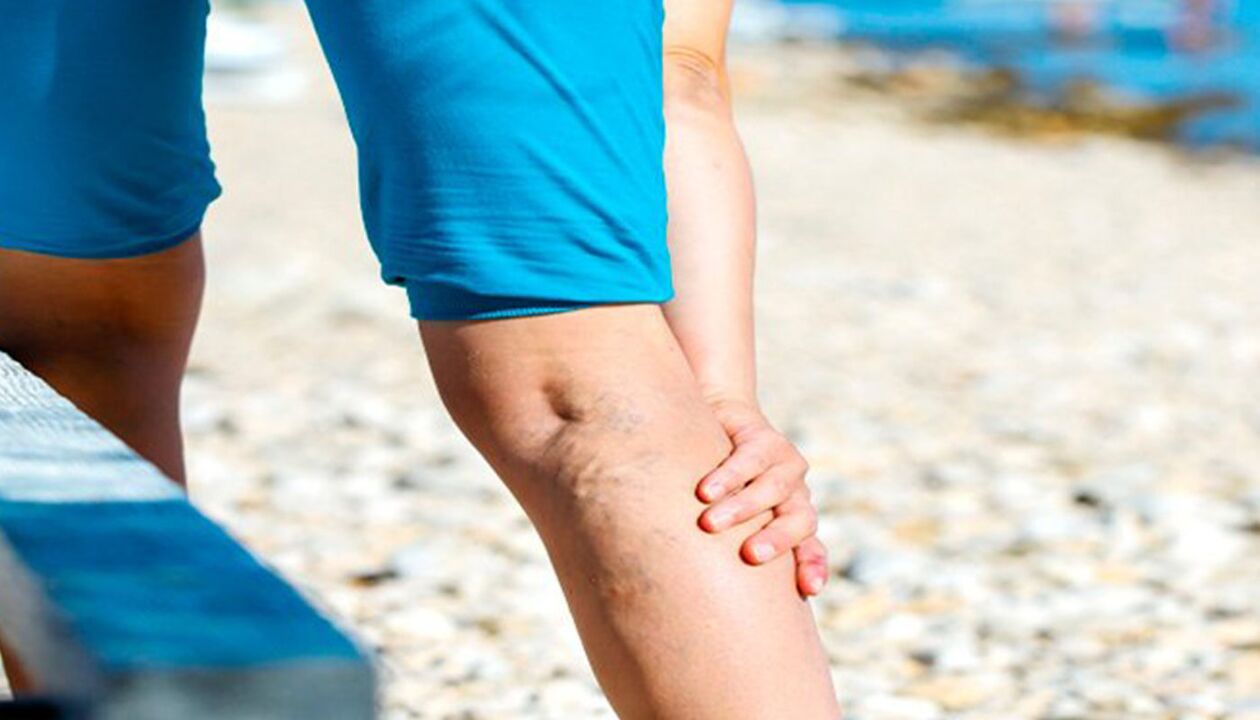
How to get rid of varicose veins on the legs? Varicose veins of the lower limbs are the scourge of modern man.
There are many people in the world who have been suffering from this malignant disease for a long time. What is this disease and what does it "eat".
Varicose veins
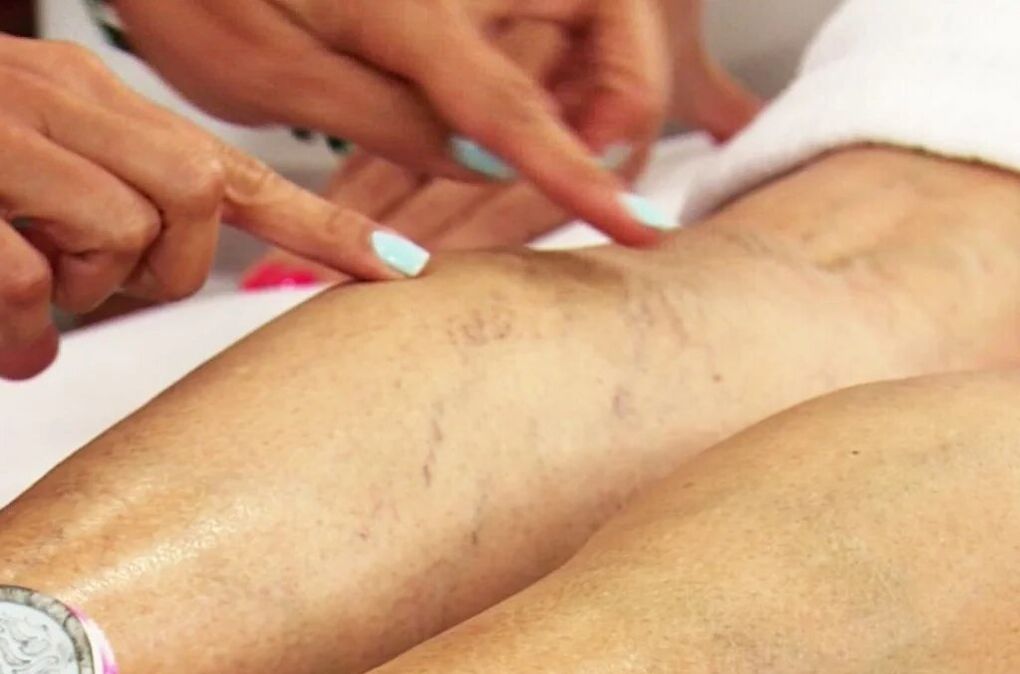
This vascular pathology, varicose veins, was one of the first "prize places" among all other vascular diseases, since it is most often diagnosed in the veins of the legs.
With this disease, the walls of the saccular veins expand. This increases the length of the blood vessels, and we can see with the naked eye their snaking tortuosity, as well as their spherical extensions (knots) throughout.
17-25% of humanity suffers from this disease. And if in youth the detection frequency of this disease is roughly the same between the two sexes. Then, in adulthood, women become leaders over men, effectively outpacing them twice.
There is a version that hormonal changes during menstruation and pregnancy lead to a weakening of the tone of the veins, which significantly expands and disrupts the venous circulation of women.
Causes of varicose veins
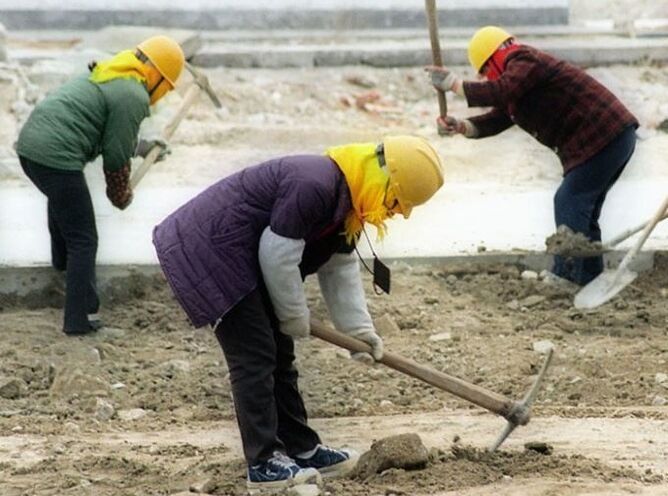
There are many reasons for the appearance of symptoms of the disease. Below I list the main ones, read carefully, if you have such a disease, you may develop varicose veins at the same time.
The disease is genetically determined by the underdevelopment of the valve function of the veins, which is aggravated by the underdevelopment of the connective tissue components within the vessel wall.
And now the pressure in the veins themselves increases, and from early childhood, as soon as the first physical activity appears, varicose veins appear.
This group includes people with congenital hypercoagulation factors. This leads to the formation of blood clots, which do not allow blood to circulate freely and lead to the expansion of the lumen of the vessels.
I have already outlined the menstrual cycle and pregnancy of women above. Menopause comes with age, estrogen decreases, progesterone rises at the same time, and this is another reason, because usually blood clotting factors increase.
And to this must be added the decrease in the synthesis of collagen, elastic fibers, which lose their functions within the wall and reduce the tone of the walls of the venous vessels. The picture is that blood flow decreases, valvular insufficiency appears and blood clots form.
Because one risk cannot be ignored. Especially in the abdominal type, when it turns out that obesity has a mechanical effect on the vein walls due to the increase in pressure under the compression zones.
In connection with insulin deficiency, the entire metabolism in the body is distorted.
Hyperglycemia leads to a decrease in the elasticity of the walls of blood vessels and an expansion of the lumen.
Alcohol can remove fluid from the body. Dehydration, on the other hand, leads to increased blood clotting and disrupts blood flow.
If you are constantly exposed to increased physical activity or have to be on your feet all the time. Such people have an increased risk of developing the disease due to stagnation of blood in the lower extremities and very high intra-abdominal pressure, which does not allow blood to flow to the heart at an adequate level.
In case of constipation, the intra-abdominal pressure increases the moment a person presses it. Thus, you can follow the logical development of varicose veins - the expansion of the lumen of the veins.
And in general, due to many factors: wearing high-heeled shoes, previous abdominal surgeries, serious cardiovascular diseases with circulatory failure, chronic pelvic inflammatory processes (prostatitis in men, inflammation of the appendages in women) and, of course, smoking.
- Because of heredity. The disease is genetically determined by the underdevelopment of the valve function of the veins, which is aggravated by the underdevelopment of the connective tissue components within the vessel wall.
- Due to the pathology of blood coagulation. This group includes people with congenital hypercoagulation factors.
- Because of hormonal changes. This group includes the menstrual cycle and pregnancy, as well as menopause.
- due to increased body weight. Especially in the abdominal type, when it turns out that obesity mechanically affects the venous walls.
- Because of diabetes. In connection with insulin deficiency, the body's metabolism is distorted. Hyperglycemia leads to a decrease in the elasticity of the walls of blood vessels and to vasodilation.
- Because of alcoholism. Alcohol can remove fluid from the body. Dehydration increases blood clotting and impairs blood flow.
Symptoms of varicose veins
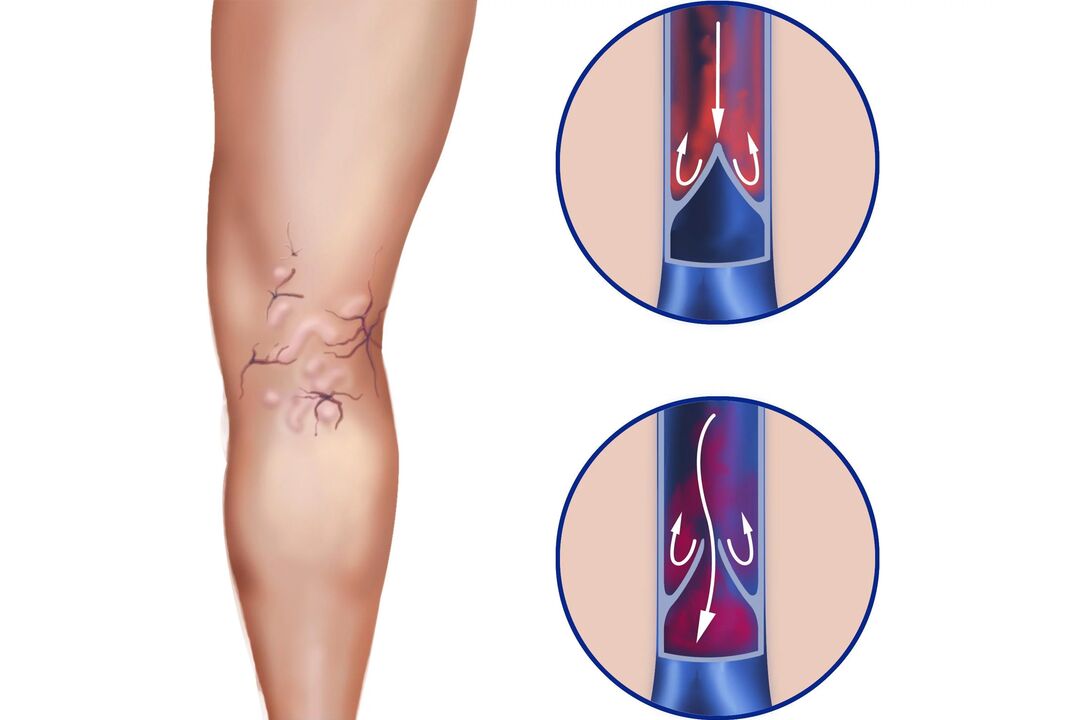
The first harbingers of symptoms of varicose veins in the lower limbs. It is worth paying close attention to them. The most important thing is not to miss them so that you can start treatment on time.
- The appearance of spider veins and webs, because the small blood vessels have already dilated and even become visible through the skin
- In the second stage, we observe the formation of protruding nodes, which twist and organize into groups.
- Obvious swelling and fatigue of the legs begin, people begin to suffer from frequent leg cramps (preferably at night), itching, fever, creeping "goosebumps".
All these symptoms appear depending on the classification of varicose veins.
On the classification of varicose veins
The international scientific community introduced the systematization of pathological varicosities using a special CEAP (Clinical Etiology Anatomy Pathology) classification. This typology includes 6 clinical stages of varicose veins:
- Zero. The patient's subjective complaints have no obvious etiology, varicose veins are suspected, but according to the results of the visual examination and research, obvious signs have not yet been identified.
- I degree. A small network of blood vessels is visible through the skin, minor, rarely occurring swelling, the appearance of the following: heaviness, burning sensation, "buzzing" sensation in the legs
- Grade II. This is already the starting point that shows the real varicose veins. Its symptoms are the external manifestation of enlarged blood vessels, the formation of venous nodes, which increase after prolonged standing on the legs or long static sitting. From this stage, the possibility of thrombosis can already be observed
- Grade III. Here, the symptoms of the second group are aggravated by the regular swelling, which is most noticeable at the end of the day, and the pulling, aching pain in the calf.
- Grade IV. Visible trophic changes on the skin. Due to the accumulation of pigment, the skin changes from dark brown to black. Small local inflammations appear and develop in the form of redness or weeping wounds, which over time cause atrophy of the dermis and ulcers.
- Grade V. It has similar symptoms as in the fifth stage, but with healed trophic ulceration
- Grade VI. It is caused by already severe progression and the formation of non-healing wounds and ulcers
Compulsory treatment of varicose veins is necessary, otherwise a complication may occur in the form of acute thrombophlebitis and perforation of the nodes (when even the slightest mechanical impact can lead to elongation and thinning of the vein leading to breakthrough); the bleeding in this case is very strong and leads to great blood loss.
Diagnostics
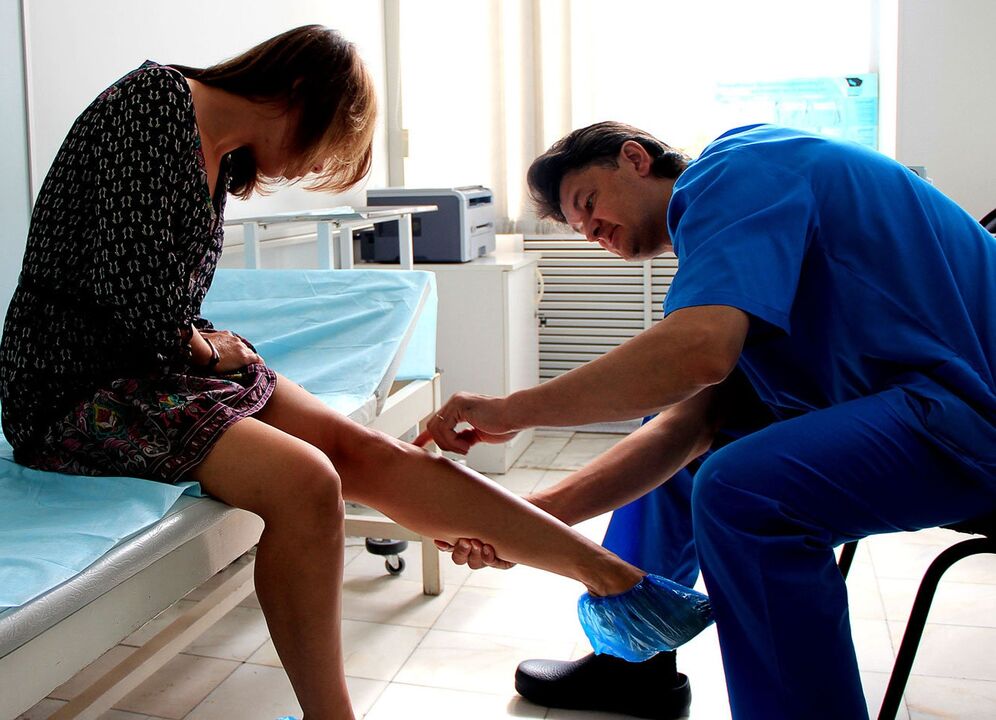
You have to go to a phlebologist for an appointment. Those who will be able to identify varicose veins at a glance, but nevertheless collect anamnesis, will listen to their complaints.
There are special functional tests that must be prescribed by the doctor.
In addition, there will be instrumental diagnostic methods, including X-ray contrast angiography and ultrasound in duplex Doppler scanning mode.
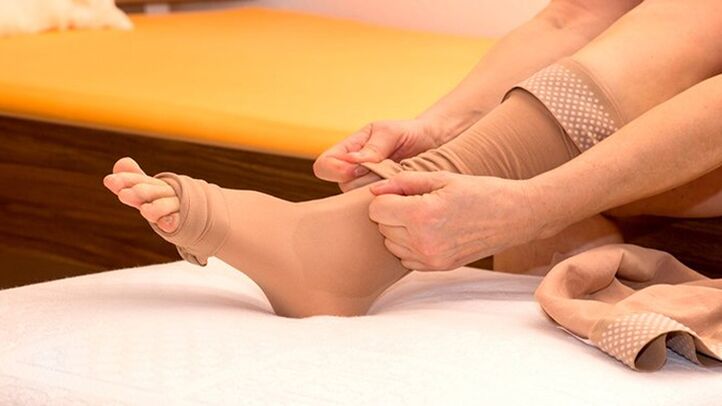
Everything about the treatment of varicose veins
A few decades ago, it was still the case that he went to a phlebologist, there he would have 100% vascular surgery, otherwise veins were not treated then.
But in the last 10-15 years, high-tech small and micro-invasive techniques have been used, such as:
- Sclerotherapy (artificial obliteration, the vein walls are "glued" with a special solution, injected with microneedles)
- Application of laser therapy
- Treatment with radiofrequency ablation (the thinnest probe is inserted into the vein, then gradually removed and the walls are "soldered")
In these cases, you no longer have to endure a major, traumatic surgery.
In addition, a complex type of powerful therapy is added, which includes the appointment of venotonic drugs, anticoagulants, antiplatelet drugs and anti-inflammatory drugs.
A good efficiency makes it possible to:
- Elastic binding and compression stockings
- Hirudotherapy
- Diets
- Therapeutic practice
- Water procedures
Attention: the use of elastic bandages or compression stockings is possible only after consulting a doctor (in particular, he explains in detail the technique of bandaging - you need to start from the fingers, with the obligatory grip of the heel, and gradually loosen the bandage. compression closer to the knee)
However, it should not be completely forgotten that varicose veins still belong to the category of surgical diseases. And if, according to the advanced stage, a radical effect is necessary according to the indications, then it can only be achieved with surgery.
One of the basic operations is phlebectomy. The vein is removed, and the dry residue of the functional viability of the vein is only 10% of the norm.
Still, it is better to do it without going to the extreme stage, varicose veins of the lower extremities can be completely cured if you consult a phlebologist without delay (however, this applies to all diseases).
There is absolutely no need to take the matter to "major" surgery: the lower limb varicose veins are now completely healed, but this disease will not go away "by itself".
Conclusion
No wonder they say: "a person's salvation is in the hands of the person himself. "And although varicose veins are not an easy disease and tend to progress quickly, only 10 years will be enough, from the zero degree of varicose veins to the development of the 6th degree pathology.
In general - this is what you need, carefully consider the first manifestations of symptoms and consult a doctor - a phlebologist.
Take care of yourself, pay attention to the first news that the body shows about the beginning of pathological changes in the veins. It is always easier to prevent than to cure the advanced stage of any disease. All health.























